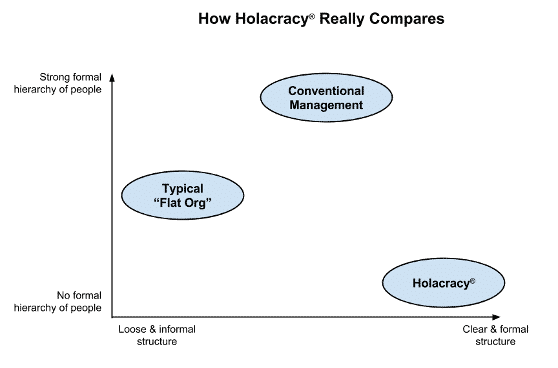Holacracy & transforming traditional organizations
As a business owner, your choice of organizational structure is a significant decision that can be rewarding if it matches the culture you want to establish. We all know that a functional organizational structure is crucial to teamwork, efficiency, work morale, culture, balance and growth, and ensures businesses can quickly react when there are changes in the marketplace.
The traditional hierarchical structure – created in the 20th century – is still widely adopted by many organizations today. While traditional architecture has been a huge success, its efficiency has become increasingly questionable. More and more businesses now favour the holacratic organizational structure.
But is it really time for a shift? Or is the traditional structure still reliable? Well, before deciding what may work best for the modern-day organization, it would be best to define what traditional and holacratic structures really are.
The traditional hierarchical model (conventional management) is a structure that keeps power in the hands of the upper management and those presiding over a company. There is a chain of command – typically with a CEO who has the final say and departmental managers who run the daily operations of the business and report to the CEO. The military is an excellent example of the traditional hierarchical model, as every soldier report to a commanding officer, with the president as commander-in-chief.
The holacratic model is a decentralized structure that eliminates hierarchical management roles. A collective process distributes authority across explicit roles within its structure. Employees filling those roles are having the flexibility to handle a range of tasks and have full authority to execute operationally.

Holacracy is not equal to a flat org as many believe, it has far less hierarchy but much more structure with fewer places to hide. It makes the implicit explicit.

Is it time for a shift?
In holacracy, power distribution is not just about taking authority off the hands of the person at the top and transferring it to someone else or a group of persons. Instead, authority shifts from the leader to a clear process, which is defined by a detailed written document (Holacracy constitution). The first step for an organization that adopts holacracy is to have the current power holder cede authority, which means they operate under the same rules as everyone else. Hence, shifting from a traditional model to holacracy might be a culture shock for many used to work in traditional structures for years.
But, in this age of disruption and with technological advancement moving at such a rapid pace, it is now, more than ever, crucial for companies to adopt an organizational structure that evolves and adapts to change rapidly.
So, is holacracy the ideal structure for today’s traditional industries?
Factory work, for instance, typically requires continuous round-the-clock activity, with labourer working shifts and putting in the work to deliver specific results. Would a holacratic structure work in this kind of setting? Would a process-centric system yield results in a labour-intensive factory environment where top-down decision-making is the norm?
A traditional hierarchical structure tends to slow down operations. For example, if new supplies are needed to satisfy a client’s order, an approval from the upper management will be required before the transaction goes through. What’s more, when bad decisions are made at the top, its effect can yield decreased productivity. Some employees may feel like they are best suited for the job than the management, leading to tensions.
It is for this reason that most companies are shifting towards a structure that has no boundaries, and swiftly addresses consumer demands. According to Oxford economist Eric Beinhocker, “the key to doing better is to bring evolution inside.” Holacracy makes it possible to achieve that, as it integrates a dynamic that encourages continuous evolution. It also creates fast, agile and purpose-driven organizations, free from tyranny and focused on getting things done.
What do you think?
All this is easy to say – or write about – but hard to do in real life. This is especially true when redesigning traditional structures. Hence, I’m contemplating using a hybrid model instead of the radical transformation of a traditional organization.
Please share your thoughts and experiences, especially when it comes to transforming traditional organizations.
PS: Here is an example of a structure in a Holacracy-powered company – you can click around and explore.
Original article: https://www.linkedin.com/pulse/holacracy-transforming-traditional-organizations-tim-frederik-kohler/
Image Source: © AS-Schneider

